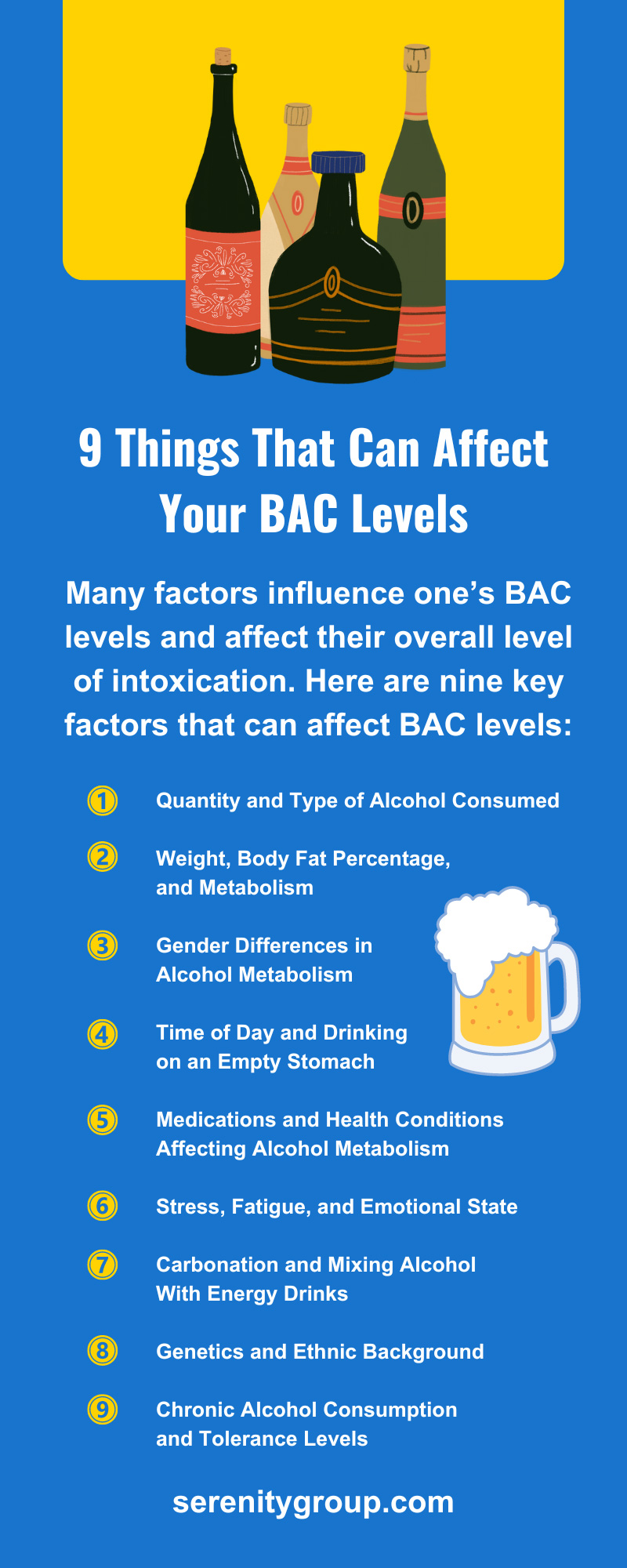9 Things That Can Affect Your BAC Levels

With each sip of that celebratory champagne or swig of beer at the local pub, you’re not just tasting a beverage; you’re entering a complex chemical dance that can have very serious consequences, particularly if you plan on getting behind the wheel. Blood alcohol content (BAC) is the key player in this tale, dictating your level of impairment and, in many cases, deciding the fate of your safety and that of others around you.
Let’s walk through nine crucial elements that can affect BAC levels to empower you with knowledge that’s vital for every driver and health-conscious individual.
What Exactly Is BAC, and How Is It Measured?
Understanding what BAC is and how it’s gauged is critical. BAC measures the weight of ethanol in a certain volume of blood, which is quantified as a percentage to indicate an individual’s level of intoxication.
A breathalyzer or blood or urine test is administered to assess BAC. Breathalyzers are the most common methods, as they are noninvasive and can provide instant results. The legal threshold for BAC varies by state, but generally, drivers are considered impaired at a BAC of .08 percent.
Quantifying the Sip: Factors That Influence BAC
Many factors influence one’s BAC levels and affect their overall level of intoxication. Here are nine key factors that can affect BAC levels:
1. Quantity and Type of Alcohol Consumed
Cocktail content matters. Different types of alcohol have different ethanol content—vodka is about 40 percent ethanol, while most beers and wines are around 5 to 15 percent. The kind of alcohol you’re drinking can also affect how fast you drink it; for instance, a shot of liquor goes down more quickly than a glass of wine. The total volume also plays a role; your body can only metabolize about one standard drink per hour.
2. Weight, Body Fat Percentage, and Metabolism
A person’s weight and body composition affect BAC levels. The less you weigh and the more body fat you have, the higher your BAC will rise. Metabolism is your body’s speedometer for alcohol processing. The faster your metabolism, the quicker your body filters out the alcohol.
3. Gender Differences in Alcohol Metabolism
Women generally have a lower body water content and higher body fat percentages than men. Because alcohol isn’t stored in fat, this leads to a higher BAC for a woman who consumes the same amount of alcohol as a man. It’s important to note that women’s enzymes metabolize alcohol at a slower rate than men’s enzymes, impacting how alcohol affects their bodies.
4. Time of Day and Drinking on an Empty Stomach
Your body is a finely tuned machine, and the time of day can affect how your body handles alcohol. For example, your metabolism is higher in the afternoon, meaning your body will process alcohol more quickly. Fasting also accelerates the absorption of alcohol. That 5 o’clock glass of wine on an empty stomach will pack more punch than one with a full meal.
5. Medications and Health Conditions Affecting Alcohol Metabolism
Some medications and health issues can interfere with liver function or depress the central nervous system, slowing alcohol metabolism. Conditions such as diabetes and hypoglycemia can magnify the effects of alcohol. Always check with a health-care professional on the interactions.
6. Stress, Fatigue, and Emotional State
Cortisol, the stress hormone, can elevate BAC by constricting blood vessels, slowing alcohol absorption, and increasing distribution within the body. Fatigue has a similar effect, reducing the body’s ability to efficiently metabolize alcohol. Mood can also influence drinking tendency and speed, thus altering BAC.
7. Carbonation and Mixing Alcohol With Energy Drinks
Carbonation can increase alcohol absorption, as can mixing alcohol with energy drinks, which often contain caffeine. This can create a paradoxical effect, where the individual feels less drunk due to the stimulating effects of caffeine but is actually more impaired.
8. Genetics and Ethnic Background
Alcohol dehydrogenase and acetaldehyde dehydrogenase are enzymes that metabolize alcohol. Variations in these enzymes due to genetics can result in different alcohol breakdowns, leading to variations in BAC and alcohol tolerance levels.
9. Chronic Alcohol Consumption and Tolerance Levels
Regular drinkers build a tolerance to alcohol, meaning they might not feel its effects at a lower BAC. However, this does not equate to unaffected performance. Chronic drinkers generally have slower reaction times and reduced motor skills when they’re driving, even if they don’t feel intoxicated.
Each factor listed above can affect BAC levels, sometimes significantly enough to transform a seemingly safe drink into a serious liability. This isn’t just about the legal implications; it’s about safeguarding your health and the welfare of others.
Managing BAC Levels and Safe Practices
Safe drinking practices and responsible decisions are vital. Always appoint a sober driver or use alternative transportation if there’s a possibility that you’re over the BAC limit. Don’t hesitate to reach out for designated sober-driving services and explore the potential benefits of an FR-44 insurance policy in securing your legal and financial well-being in the event of a DUI conviction.
Develop and employ strategies such as the one-drink-per-hour rule, knowing your limits, and familiarizing yourself with behaviors at different BAC levels. The consequences of impaired driving can be life-altering, and it’s not just about avoiding legal repercussions. It’s about making choices that align with a commitment to safety for yourself and for the community you share the roads with.
BAC is more than just another acronym; it’s a metric that can distinguish between a night of fun and a night that takes a tragic turn. By understanding the factors that can affect your BAC levels, you’ll be equipped to make informed decisions that champion safety and mindfulness in every social setting.
Our team at Serenity Group encourages you to share this guide with friends and family members to spark conversations around safe drinking and the responsibility that comes with it. Each reader won’t just be a safer driver; they’ll be an ambassador for a culture of accountability and health in our communities.
Remember, in your adventures with alcohol, knowledge is your best ally. Insight keeps you in control, no matter the gravity of the situation. Be smart, be safe, and enjoy the festivities with the dignity they deserve.


Recent Comments